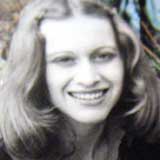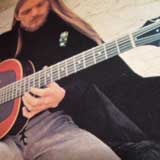
Elaine Elkington
Ian Keay: I first met Ian and his sister Jane when I was 14 - and had just had my appendix out after a school emergency before the Christmas holidays. Ian, who would be our best man in 1973, introduced me in the mid-1960s to the thinking of Buckminster Fuller and to a whole raft of science fiction writers.
Jane Keay: Though a couple of years older, Jane asked me to Charleston a few weeks after my appendicectomy. I was, as they say, sorely tempted. My first real girlfriend and still a very close friend.
The Palmers: Cousins of the Keays and living in the same village, we also grew up alongside Nigel, Cally and Debby. Their parents, Judge Jack and Vanda (Bunny) Palmer were wonderful hosts.

Elaine Elkington
Martin Lindsay: Another friend at Essex University, Martin introduced me to the music of Fairport Convention (It's Alright, Ma, It's Only Witchcraft) and to the more esoteric aspects of America's West Coast sound.
Rex Gowar: Also a friend from Essex days he kept an eye on me during my first and only LSD trip.
Shawn Phillips: A musician we met in Positano, Italy, on our way to Greece. Three of us, Rex, Ian Lovell and I, spent an extraordinary night in Shawn's hilltop house, listening to music he had just recorded with the likes of Paul McCartney and Stevie Winwood. www.shawnphillips.com

Shawn Phillips
Stewart Brand: The man behind so many things, but the key is his Whole Earth Catolog series, which I devoured through the 70s.
Buckminster Fuller: I read most of his books, though it wasn't easy, and finally met the man in Reykjavik in 1977. His concept of ephemeralization and notion of 'doing more with less', as with geodesic domes, were direct precursors of eco-efficiency.
Frank Herbert: Herbert's Dune series entertained me for years. I tried to meet up with him but somehow our paths never coincided - until we finally made it happen as I flew in from Seattle and he prepared to leave London for the reverse trip. The conversation was captured in a couple of articles, including a piece for Earthlife News.
Hollister T. Sprague: A WWI American fighter pilot, he later worked as Mr Boeing's lawyer in Seattle. A first cousin of my grandmother Isabel, he looked after Elaine and I on our 1973 honeymoon, escorting us across the Cascades and up into the Olympic Peninsula. His home, Forestledge, overlooking Puget Sound, became a regular holiday destination for us.
Chuck and Jeanne Branson: Via Hollister, we met his sister
Joan
(pronounced Jo-Anne) and her husband Elon, who lived on a ranch near Yakima,
on the other side of the Cascades. Closer to hand, indeed just along the bluff
on which stands Hollister's extraordinary house, Forestledge, lives his niece,
Jeanne and her husband Chuck and family. Hollister, Joan and Elon are long
dead, but the links live on.
Elaine Elkington: In retrospect, meeting Elaine in 1968 was the pivotal point in my life. We married in 1973 and she has been a Muse and hugely powerful influence in every aspect of my life since.
Dr Stanley and Margaret Waite: They weren't at all sure of what to make of me at the outset. The fact that I had (very) long hair, beads and an antique Dior jewelled waistcoat probably didn't get us off on quite the right foot, nor did the fact that all my grandparents had got divorced, and at least two had subsequently divorced again. But things soon improved - and I'm hugely grateful to them for helping us buy our Barnes home, even though they were horrified when they saw the ruinous state we were living in.
Once the process of meeting cousins
started, it continued. Most notable have been Charlotte and Clark Turner,
whose house fronting directly onto Puget Sound on Vashon Island has been a
wonderful retreat - with Hania catching her first and only salmon from the
foreshore. Among the things that stand out in memory are horse-riding in the
hills around Yakima with Elon, sailing with Clark and Charlotte around Puget
Sound, and being taken to our first and only drag race with (not entirely
in character) the Bransons.
Robin Clarke: Previously editor of the Science Journal, a precursor of New Scientist, Robin founded Biotechnic Research & Development (BRAD). BRAD was somewhat akin to John Todd's New Alchemy Institute in Cape Cod. It was a fascinating combination of solar energy, windmills, fish ponds and the sort of social dysfunction you often found in low-discipline intentional communities or communes.
John Todd: My shelves still contain several editions of The Journal of the New Alchemists. A pioneer in such areas as intentional communities and aquaculture, particularly tilapia farming.
John C. Lilly: Mad as a hatter, at times, probably because of all the LSD he took. But his work on dolphins, (including building channels that brought them into his home), sparked something in my imagination www.johnclilly.com.
Gavin Young: I was fascinated by Gavin's experience of living with the Marsh Arabs of Iraq (see his Return to the Marshes), to whom he was introduced by Wilfred Thesiger, and by his sense of Vietnam's history, where he had spent a great deal of time.
Paolo Soleri: In 1973, Elaine and I visited Soleri's Cosanti Foundation and Arcosanti project, which led to my first speech and article. Originally a pupil of Frank Lloyd Wright, who had dreamed of 'Broadacre City', with every family allocated a 1-acre lot, Soleri went for something more like human termitaries, super-dense cities built into massive dams or other giant structures. Arcosanti was fascinating, but a storey or two high at best. My AAQ article mused that it would make a great set of ruins.
Joan Davidson: She taught me rural environment subjects at UCL in 1972-74 - and was one of the first people to recommend that I take up writing professionally.
Mike Franks: I met Mike when working with TEST. He was an architect-planner at the GLC office across the road in London's Covent Garden. We shared a common interest in cities as ecosystems. Later, we (ENDS) took an office in the huge office complex Mike's company, Regeneration, had redeveloped in Clerkenwell. ENDS is still there some 20 years later.